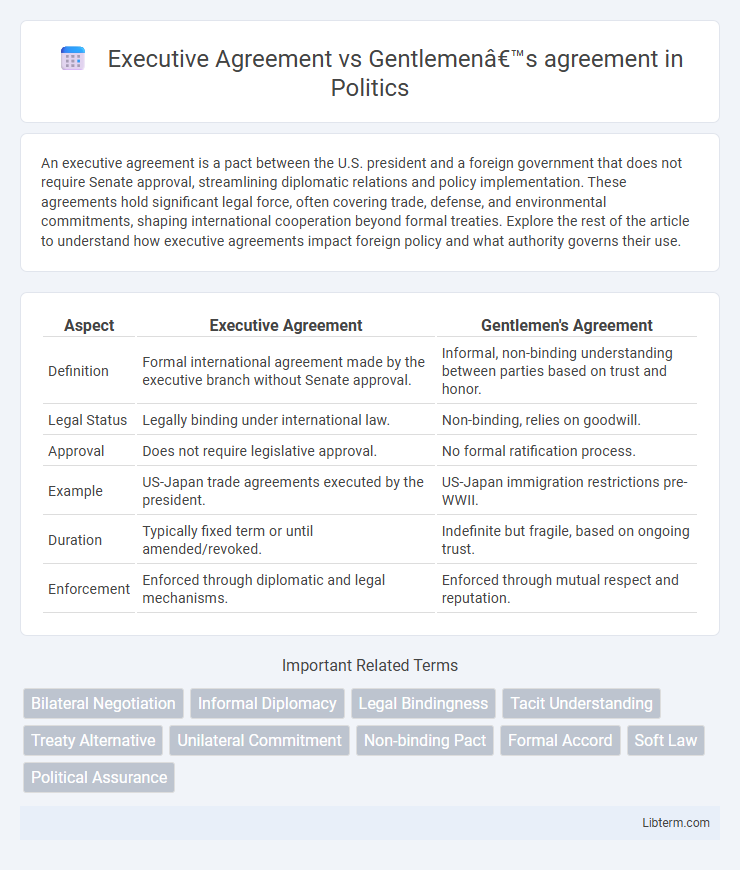An executive agreement is a pact between the U.S. president and a foreign government that does not require Senate approval, streamlining diplomatic relations and policy implementation. These agreements hold significant legal force, often covering trade, defense, and environmental commitments, shaping international cooperation beyond formal treaties. Explore the rest of the article to understand how executive agreements impact foreign policy and what authority governs their use.
Table of Comparison
| Aspect | Executive Agreement | Gentlemen's Agreement |
|---|---|---|
| Definition | Formal international agreement made by the executive branch without Senate approval. | Informal, non-binding understanding between parties based on trust and honor. |
| Legal Status | Legally binding under international law. | Non-binding, relies on goodwill. |
| Approval | Does not require legislative approval. | No formal ratification process. |
| Example | US-Japan trade agreements executed by the president. | US-Japan immigration restrictions pre-WWII. |
| Duration | Typically fixed term or until amended/revoked. | Indefinite but fragile, based on ongoing trust. |
| Enforcement | Enforced through diplomatic and legal mechanisms. | Enforced through mutual respect and reputation. |
Understanding Executive Agreements: A Formal Approach
Executive agreements are formal international commitments made by the executive branch of a government without requiring legislative approval, ensuring swift and binding implementation of foreign policies. They differ from gentlemen's agreements, which are informal, non-binding understandings based solely on trust and political goodwill between parties. Understanding executive agreements involves recognizing their legal enforceability under international law and their frequent use in trade, security, and diplomatic relations to expedite government actions.
Defining Gentlemen’s Agreements: Informal Pact Explored
Gentlemen's agreements are informal, non-binding pacts characterized by mutual trust and honor rather than legal enforceability, often used in diplomatic or business contexts to facilitate cooperation without formal contracts. Unlike executive agreements, which are official and legally binding arrangements made by government executives, gentlemen's agreements rely solely on the goodwill of the parties involved, making them flexible but inherently uncertain. This informal nature allows for rapid consensus but lacks the enforceability and transparency typically associated with formal diplomatic or legal agreements.
Legal Standing: Binding Nature Compared
Executive agreements carry formal legal authority, binding the parties under international law with enforceable terms, unlike gentlemen's agreements which rely on trust and lack legal enforceability. Gentlemen's agreements function as informal, non-binding understandings typically used to maintain flexibility and confidentiality between parties. The binding nature of executive agreements often involves formal government approval or ratification, whereas gentlemen's agreements depend solely on the honor and goodwill of the involved individuals or entities.
Historical Context: Evolution of Both Agreements
Executive agreements gained prominence during the 20th century, especially in U.S. foreign policy, as a flexible tool for presidents to conduct international relations without Senate approval. Gentlemen's agreements have roots in 19th-century diplomacy, relying on mutual trust and informal commitments between nations before the rise of formal treaties. Over time, executive agreements evolved into legally binding instruments under international law, while gentlemen's agreements remained unverifiable, non-binding understandings shaped by honor and diplomatic convention.
Key Differences in Formation
Executive agreements are formal, legally binding accords between governments, typically negotiated and signed by executive branch officials without requiring legislative approval. Gentlemen's agreements are informal, non-binding understandings based on trust and mutual respect, lacking official documentation or legal enforceability. The key difference in formation lies in the formal authorization and legal status: executive agreements involve official executive action and legal ratification, while gentlemen's agreements rely solely on informal consensus without any legal obligation.
Enforcement Mechanisms: Executive vs. Gentlemen’s Agreements
Executive agreements are legally binding contracts between governments and are enforceable under international law, often ratified by the executive branch without requiring legislative approval. Gentlemen's agreements rely on mutual trust and honor between parties, lacking formal legal enforcement and depending primarily on goodwill and diplomatic pressure. The enforceability of executive agreements provides a stronger mechanism for compliance compared to the informal, non-binding nature of gentlemen's agreements.
Implications in International Relations
Executive agreements shape international relations by allowing rapid, flexible policy implementation without Senate approval, often enhancing diplomatic agility and confidentiality. Gentlemen's agreements rely on mutual trust and informal commitments, which can strengthen bilateral relations but lack legal enforceability, potentially leading to uncertainty and varied compliance. The choice between these agreements impacts the durability of international cooperation and influences diplomatic leverage and accountability in foreign policy.
Transparency and Accountability Factors
Executive agreements, formal and legally binding between governments, require transparency through official documentation and are subject to international law, ensuring accountability via diplomatic and legal channels. Gentlemen's agreements, informal and non-binding understandings, lack official records, reducing transparency and making accountability dependent on mutual trust and goodwill between parties. The differing nature of these agreements significantly impacts enforcement, with executive agreements offering clearer mechanisms for oversight compared to the reliance on reputation in gentlemen's agreements.
Notable Examples and Case Studies
Executive agreements include the 1945 Yalta Agreement between the U.S., U.K., and Soviet Union, allowing wartime collaboration without Senate ratification, while notable gentlemen's agreements encompass the 1907 U.S.-Japan arrangement limiting Japanese immigration informally. In U.S. foreign policy, executive agreements like the 1994 North American Free Trade Agreement (NAFTA) demonstrate legally binding commitments bypassing formal treaties. Gentlemen's agreements rely on trust and honor, exemplified by the 1921 Washington Naval Conference, which sought naval disarmament through informal understanding rather than enforceable contracts.
Choosing the Right Agreement: Practical Considerations
Choosing the right agreement depends on the nature of the parties involved and the intended enforceability; executive agreements are formal, legally binding contracts typically used between government executives requiring ratification or official implementation. Gentlemen's agreements rely on trust and moral obligation without legal enforceability, suitable for informal, non-binding arrangements in business or diplomacy where flexibility is desired. Evaluating the need for legal recourse, party authority, and the consequences of breach guides the decision between an executive and a gentlemen's agreement.
Executive Agreement Infographic

 libterm.com
libterm.com